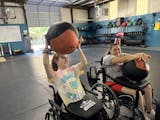Introduction to Adaptive Fitness
Adaptive fitness has traditionally been a challenging field, with limited options for athletes with disabilities. For years, the best equipment available to adaptive athletes were Smith machines or therapy bands. Equip Products changed the landscape by introducing a revolutionary approach: incorporating the barbell into adaptive fitness.
The Birth of Equip Products
Equip Products emerged as the first company to envision the use of barbells in adaptive fitness. Their journey began with a simple yet groundbreaking question: "Why not use a barbell?" This question sparked a series of innovations aimed at enhancing the fitness experience for adaptive athletes.
LapMat™: The Pioneer Product
The first product developed by Equip Products for adaptive athletes was the LapMat™. Initially designed to facilitate barbell use, the LapMat™ quickly proved effective across various fitness equipment. The primary goal was to protect the legs of paralyzed athletes from the damage a barbell can cause when rested on their legs in a wheelchair.
The Challenge of Using Barbells for Paralyzed Athletes
When a paralyzed athlete uses a barbell and slams it on their lap, they cannot feel the damage being inflicted on their legs. Equip Products discovered that able-bodied individuals could not believe the force exerted by a barbell during a simulated workout in the seated position. This insight highlighted the urgent need to protect the legs of paralyzed athletes and prevent skin sores and more severe injuries.
Preventing Severe Injuries
In rare cases, a barbell dropped on the legs of a paraplegic athlete can cause severe injuries, including femur fractures and potentially life-threatening bleeding. Equip Products recognized the importance of addressing this risk and developed solutions to prevent such accidents.
Understanding Autonomic Dysreflexia (AD)
Autonomic Dysreflexia (AD) is a condition that can arise from paraplegia, often complicating injuries. According to the National Library of Medicine, AD can be a dangerous, persistent and nagging issue for some athletes. Equip Products aimed to mitigate these risks by enhancing safety measures for adaptive athletes.
Expanding to Amputee Athletes
Equip Products soon encountered athletes with amputations or brachial plexus injuries who aspired to perform deadlifts, knee-to-bar exercises, and even bar muscle-ups. To meet these needs, they collaborated with noted amputee and Peloton Coach Logan Aldridge.
The Aldridge Arm™ Harness
Together with Logan Aldridge, Equip Products developed the Aldridge Arm™ Harness. This commercially available product enables athletes to use a barbell and other fitness equipment effectively. The harness has been a game-changer for adaptive athletes, allowing them to achieve their fitness goals safely.
Innovating with the LouP Strap
Another significant innovation from Equip Products is the LouP Strap. Developed in collaboration with Louise Hawkins, also known as Loubie, the LouP Strap assists athletes in performing cleans and, in some cases, snatches with a barbell. This product has further expanded the possibilities for adaptive athletes in strength training.
Collaboration with Louise Hawkins
Louise Hawkins, an inspiring athlete from the UK, played a crucial role in the development of the LouP Strap. Her insights and experiences were instrumental in creating a product that meets the unique needs of adaptive athletes.
Conclusion: The Future of Adaptive Fitness
Equip Products has revolutionized adaptive fitness by integrating the barbell into the workout routines of adaptive athletes. Their innovative products, including the LapMat™, Aldridge Arm Harness, and LouP Strap, have set new standards for safety and effectiveness in adaptive training. As they continue to innovate, the future of adaptive fitness looks brighter than ever.
FAQs
1. What is the main benefit of using a barbell in adaptive fitness?
Incorporating a barbell into adaptive fitness allows for more versatile and effective strength training, enabling adaptive athletes to perform a wider range of exercises.
2. How does the LapMat™ protect paralyzed athletes?
The LapMat™ provides cushioning and support, preventing damage to the legs of paralyzed athletes when using a barbell or other fitness equipment.
3. Who is Logan Aldridge, and what is his contribution to adaptive fitness?
Logan Aldridge is a noted amputee athlete and Peloton Coach who collaborated with Equip Products to develop the Aldridge Arm Harness, enabling adaptive athletes to use barbells and other fitness equipment safely.
4. What is the purpose of the LouP Strap?
The LouP Strap assists athletes with cleans and snatches, expanding the range of exercises they can perform with a barbell.
5. How does Equip Products address the risk of Autonomic Dysreflexia?
Equip Products designs their equipment with safety in mind, ensuring that adaptive athletes are protected from injuries that could trigger Autonomic Dysreflexia.



